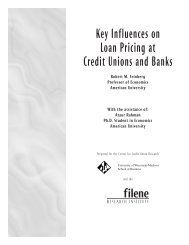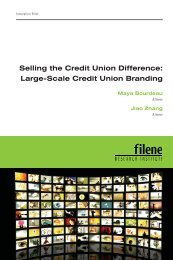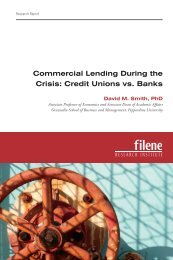Credit Union and Cooperative Patronage Refunds - Filene ...
Credit Union and Cooperative Patronage Refunds - Filene ...
Credit Union and Cooperative Patronage Refunds - Filene ...
You also want an ePaper? Increase the reach of your titles
YUMPU automatically turns print PDFs into web optimized ePapers that Google loves.
Figure 6: Potential Tax Effects of <strong>Patronage</strong> <strong>Refunds</strong><br />
27 <strong>Credit</strong> <strong>Union</strong>s as Exempt, Allocated 40% under Sub-T, <strong>and</strong> Allocated 100% Under Sub-T<br />
Average of 2008, 2009, <strong>and</strong> 2010 501(c)(14) % Total Sub-T: 40% % Total Sub-T: 100% % Total<br />
Cash patronage refund 822,800 23.34 282,076 8.0 822,800 23.34<br />
<strong>Patronage</strong> refund in allocated equity — 0.00 1,128,304 32.0 2,703,149 76.66<br />
Undivided/Unallocated earnings 2,703,149 76.66 1,184,719 33.6 — 0.00<br />
Income tax on co-op’s earnings — 0.00 930,850 26.4 — 0.00<br />
Total earnings (average per co-op) $3,525,949 100.00 $3,525,949 100.00 $3,525,949 100.00<br />
Allocate <strong>and</strong> Distribute 100% of <strong>Patronage</strong> <strong>Refunds</strong><br />
Income tax is not owed under this Subchapter T scenario, because<br />
we assume that all income is patronage sourced (generated from<br />
transactions with members) <strong>and</strong> that all patronage income is allocated<br />
to members on the basis of patronage. 31<br />
The 27 credit unions in the Callahan study are already distributing<br />
enough cash to qualify for tax treatment under Subchapter T. A minimum<br />
of 20% cash refund is required by Subchapter T. These credit<br />
unions paid 23.34%. <strong>Credit</strong> unions would prepare 1099-PATR<br />
information returns, but we expect that many credit unions could<br />
apply for <strong>and</strong> receive an exemption from reporting 1099-PATRs. 32<br />
The bigger issue for these credit unions is whether they would be<br />
able to redeem allocated equity, <strong>and</strong> whether there would be pressure<br />
to redeem this equity. At the end of their first year operating under<br />
Subchapter T, these credit unions would have allocated equity totaling<br />
$2.7M dollars. If year two were identical, allocated equity would<br />
total $5.4M at the end of that year. You can see how allocated equity<br />
would quickly build up <strong>and</strong> grow from year to year. If these 27 credit<br />
unions had been allocating earnings all along, each credit union<br />
would, on average, have $54.0M of allocated equity as of December<br />
31, 2011.<br />
A 50-year equity redemption cycle, for example, applied to $54.0M<br />
of allocated equity implies an annual equity redemption obligation<br />
of $1.08M per credit union among the Callahan study credit unions.<br />
Hence, these 27 credit unions would be expected to redeem more<br />
than $1.20 of allocated equity for every $1.00 of patronage refunds<br />
paid in cash, an objective that most likely is all but impossible for<br />
these credit unions. So what would these credit unions do if they<br />
operated under Subchapter T <strong>and</strong> were faced with that allocated<br />
equity but could not redeem it?<br />
These 27 credit unions would not redeem allocated equity unless<br />
<strong>and</strong> until they had surplus working capital to allow redemptions of<br />
equity. In fact, if the board of directors determined that the credit<br />
52








